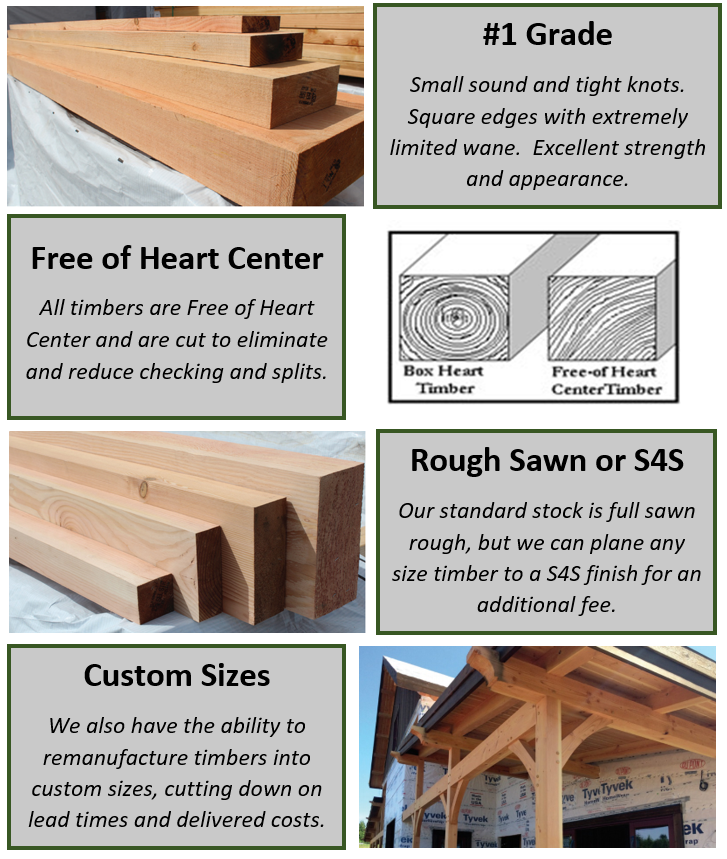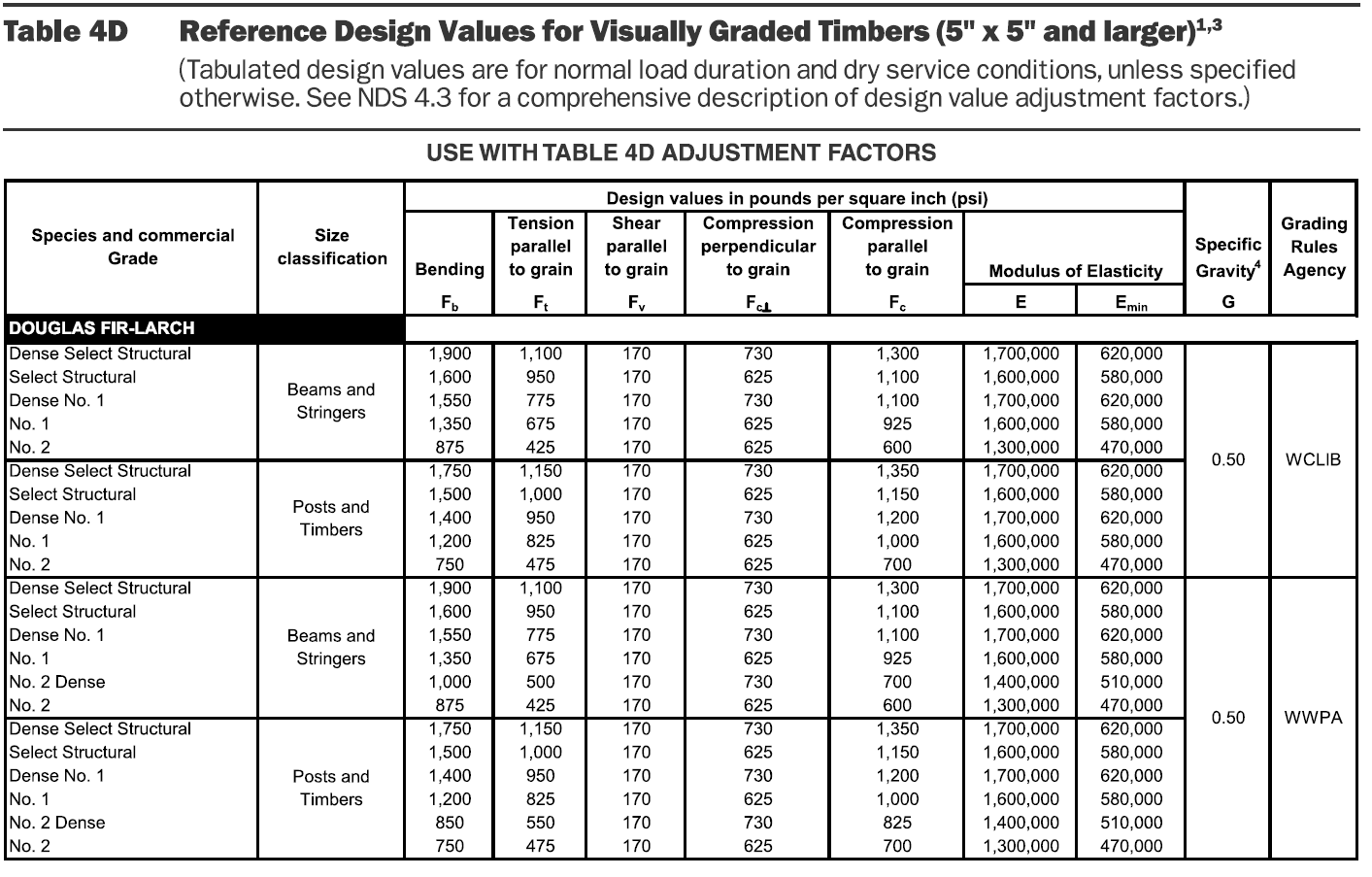Douglas Fir Timbers


Doug Fir timbers are a growing breed of wood timbers for both interior and exterior applications in the Midwest. Thanks to their high-quality appearance, predictable strength, and reasonable price point, they are an excellent fit for your big timber needs.
Available Sizes:

Features & Benefits:
-Premium appearance grade timber that is 100% Free of Heart Center and Free of Wane
-Beautiful auburn coloring and even grain
-#1 Grade for predictable strength bearing and spans
-More affordable than comparable Western Red Cedar sizes
-Available in custom sizes and in an S4S finish


Heart centers will lead to what is called "checking", which is when a long crack occurs within the timber. This happens as the timbers dries out in its final environment. Structurally there is no impact from checking and cracking in a timber, it's very natural and is simply the timber settling and stabilizing. However, those checks and cracks can be unsightly as they can run the whole length of the timber. Thus when you cut around the heart in a FOHC timber, you dramatically reduce field checking and splits and ensure a nice visual timber.
Douglas Fir Versus Cedar Timbers
Pros & Cons Comparison
EXTERIOR TIMBERS:
Exterior Douglas Fir Timbers
- Pros
- More affordable than Cedar, especially on really large timbers
- Free of Heart Centers. This helps to reduce the visual checking and cracking that you can see on the timber over time
- Structurally strong and can be designed and engineered into a project
- Cons
- Not as long lasting. You can assume a lifespan that is roughly 2/3rds that of Cedar, and could be shorter if exposed to heavy moisture that isn't properly flashed or drained
- Douglas Fir Timbers have more variability in appearance. While all make the grade, some can look less desirable to the eye than others. It's the nature of the beast.
- Doug Fir Timbers are more susceptible to surface mold. This will show up as a black or dark green mold on the timber. It can be treated and cleaned, but sometimes it will leave a longer term discoloration
- Doug Fir Timbers are heavy and dense. They weigh over 2x the weight of comparable Cedar Timbers. They are also harder on equipment and tools and not as receptive as Cedar.
Exterior Cedar Timbers
- Pros
- Beautiful even coloring and grain
- Much longer lasting than Douglas Fir. Cedar is packed with natural oils and resins that make it naturally resistant to rot, decay, and insects. It's the best performing wood species.
- Can be left raw and will naturally gray out, or can be finished to your desire
- Lightweight and easy to work with
- Cons
- More expensive than Douglas Fir (sometimes double or even triple the price)
- Not as structurally strong or supportive. Many bearing applications are better with Douglas Fir.
- Can check and crack. This has no impact on the strength or lifespan of the timber, it's purely visual
Bottom line, if looking for an exterior exposed timber, Cedar is the best overall performing Timber. However, there are plenty of applications where a Douglas Fir timber can be an equal choice and save you money.
INTERIOR TIMBERS:
Douglas Fir Timbers
- Pros
- More affordable than Cedar, especially on really large timbers
- Free of Heart Centers. This helps to dramatically reduce the visual checking and cracking that you can see on the timber over time
- Structurally strong and can be designed and engineered into a project
- Can be surfaced to a smooth S4S finish which looks amazing
- Cons
- Douglas Fir Timbers have more variability in appearance. While all make the grade, some can look less desirable to the eye than others. It's the nature of the beast.
- Douglas Fir Timbers can also develop a pitch pocket which releases a resinous sap over time. It rarely occurs, but in an interior application, this can leach and drip onto furniture, carpets, etc. and become a problem.
Interior Cedar Timbers
- Pros
- Beautiful even coloring and grain
- Lightweight and easy to work with
- Cons
- More expensive than Douglas Fir (sometimes double the price)
- Not as structurally strong or supportive. Some bearing applications are better with Douglas Fir.
- Can check and crack. This has no impact on the strength or lifespan of the timber, it's purely visual
Bottom line, if you're looking for an interior exposed timber, we think that Douglas Fir Timbers are a slightly better option. They are more affordable, look great, and achieve the natural timber look you're going for.
Covered and Exposed Exterior - Brentwood, MO
Rough Sawn Douglas Fir:


Covered and Exposed Exterior:
Rough Sawn Douglas Fir:


@texasforeverfarmhouse

@prairiefarmhousedesign


@palmersstonecottagefarm
Exposed Interior:
Rough Sawn Douglas Fir

@beckiowens

Smooth (S4S) Douglas Fir

@clearcutandco
Painted Exterior:
Smooth (S4S) Douglas Fir

@artisansignaturehomes
Covered Pavilion - Kansas City, KS
S4S Doug Fir Timbers & 2x6 T&G Fir Roof Decking


Frequently Asked Questions:
Q: Is this a premium or construction grade?
A: A #1 Free Of Heart Center is a high-quality appearance timber. It’s the ideal balance of strength and appearance and is excellent for exposed applications. Free Of Heart Center (FOHC) means that the timber is specially cut so that there is no heart center (bulls eye) which over time leads to checking.

Q: What is the strength rating?
A: All Doug Fir timbers are a #1 or better, and have predictable and designable strength ratings. Contact one of our engineers to properly determine the correct size timber for your application.
Q: What are the net sizes of these timbers?
A: All rough sawn timbers are full sawn rough, meaning their actual size will match the nominal size. Anything S4S will be a net roughly a 1/4" smaller.
Q: When should I use Doug Fir versus Cedar?
A: While Fir Timbers are more affordable than Cedar timbers, they do have some limitations. They can be used in an exterior environment but they won’t weather as well as Cedar and will have a shorter life-span. Common Doug Fir Timber applications are interior exposed beams and posts, strength bearing beams and posts, large timbers bigger than 6x6, and timber-framed trusses.
Q: Are these eased edges or square edge timbers?
A: Square edge.
Q: What is the lead time for a custom timber?
A: Assuming the needed cant is in stock, figure two weeks or sooner.
Q: Can you also do custom length timbers?
A: Yes, we have a P.E.T. saw that can cut timbers to a precise length.
Q: What about Timbers longer than 24’ or bigger in size than your stock items?
A: Because we are regularly ordering stock timbers, we can add those special orders to our regular inbound trucks. So they are available, just with a slightly longer lead time.
Design Values:

PDF: American Wood Council Span Tables
PDF: American Wood Council Design Values
PDF: Doug Fir Timber Grading Rules

@beckiowens
